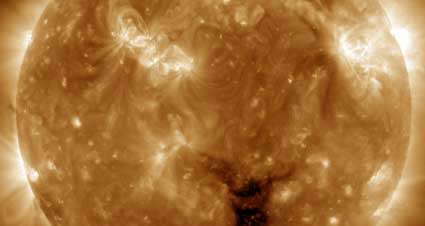Astrophysicists tackle the Sun and one of physics' biggest unsolved problems

Daniel Wolf Savin and Michael Hahn have been fascinated by the universe since they were boys. For Savin, a senior research scientist in the Columbia Astrophysics Laboratory, discovering Albert Einstein at age 12 spurred the desire to "learn everything about the universe." Years later, Hahn, an associate research scientist who grew up 40 miles from Savin's home town in Connecticut, started gazing at the stars as a teenager; he eventually became president of the astronomy club at his alma mater, Carnegie Mellon.
Now the two have made a big leap toward cracking one of the biggest mysteries in astrophysics—why the corona, or plasma surrounding the sun, is so much hotter than the sun's surface.
The coronal heating problem, as it is known, is important because the corona is the source of solar wind, which is responsible for the northern and southern lights and can also disrupt telecommunications and power grids. "Satellites can be slowly pushed out of their orbits if they're deflected by the solar wind so if we can better understand the cause, we can create better models for space weather," says Savin, referring to conditions beyond the atmosphere.
Scientists have proposed two main theories to explain why the temperature of the gas in the corona, which lies above the solar surface, soars to over 1 million degrees Kelvin even though the surface of the sun is a relatively cool 6,000 degrees. (The center of the sun is 15 million degrees.)
This unexpected phenomenon has puzzled researchers since 1939, when scientists first discovered the temperature difference; it's as if a flame were coming out of an ice cube.

One theory attributes the excessive heat to loops of magnetic fields that span the solar surface and can snap, releasing energy. The other ascribes it to magnetic waves emanating from below the solar surface, which carry magnetic energy and deposit it in the corona, a process called damping.
Both of these processes occur on the sun. But scientists had previously been unable to determine if either mechanism released sufficient energy to heat the corona to such high temperatures.
As observational physicists, Savin and Hahn don't conduct research by looking up at the sky as experimental physicists do. Instead, they examine public domain data, much of it collected by satellites. Their team analyzed data from the Japanese satellite Hinode, which carries an Extreme Ultraviolet Imaging Spectrometer that measures wavelengths by determining where they lie on the color spectrum.
They used observations of a polar coronal hole, a region of the sun where the magnetic fields stretch from the solar surface far into interplanetary space, and found that damping was the most likely explanation.
The magnetic waves contained enough energy to heat the corona, the team discovered, and the waves deposited most of their energy at a level that allowed the heat to spread throughout the corona. By examining the width of the spectral lines, Savin and Hahn were able to infer the temperature emitted by the waves, as well as how much energy the waves had lost. And they determined an amount equivalent to about 90 percent of the energy needed to heat the corona. The findings were published in the Sept. 30 edition of The Astrophysical Journal.
"Our work is a major advance in solving the coronal heating problem, though it doesn't resolve every issue," says Hahn. Chief among them is the cause of the wave damping—the next mystery the team will tackle.
Savin, whose office is in Pupin Hall, graduated from Columbia College in 1985 with a degree in physics. He got his Ph.D. from Harvard and returned to Columbia in 1996 as an associate research scientist. Hahn graduated from Carnegie Mellon in 2005 with a degree in physics and came to Columbia for graduate school, receiving his doctorate in applied physics in 2009—the same year he joined Savin's team.
The two decided to focus on coronal holes because they are the simplest structures in the corona and therefore the ones they were most likely to understand best.
As teenagers captivated by the movement of stars and planets, neither could have pictured their professional lives as scientists. "If you had asked me at the age of 12 what I thought being a scientist meant, I would not be able to tell you it was close to what I do today," Savin admits, referring to the papers, journal reviews, proposals, conferences and endless planning—not just working in a lab wearing a lab coat or staying up late looking at stars. "All of those aspects are critically important for creating an environment where one can do science but it's not 'doing science' as I imagined as a child."
Journal information: Astrophysical Journal
Provided by Columbia University





















